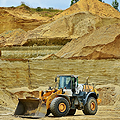HOW DOES A STONE CRUSHING PLANT WORK?
July 26, 2017
Dictionary definitions don’t give stone crushing plants the credit they deserve. Sure, the crushing jaws break boulders into smaller rocky chunks, but they do so with a measure of raw destructive power that defies description. Just how does the heavy-duty equipment employ these compressive forces? How does a stone crushing plant work? Well, before going any further, those heavy impact tools are going to need a power source, right?
LEVERAGING DUAL POWER SOURCES
Channelled into the primary jaw crushers, it’s electrical power that actuates a series of reciprocating motors. They’re the components in the process that deliver the ultra hard stones to the primary crushing station. Then, once the dense lumps enter the jaw housing, hydraulic energy clamps the crushing mechanism until the stones crack into smaller chunks. The gear is partially automated, so a mechanical screening system acts as the fragment sizing component, with the oversize conveyed forward while the undersize is routed to a separate processing channel. Essentially, the primary crushing stage uses a robust line of electrical motors and hydraulic-powered crushing jaws to reduce the stones until they take on a more manageable size.
EMPLOYS EXTRA CRUSHING EQUIPMENT
In a standard mine, the bulk of the crushing work would be finished. A secondary crushing stage, a number of screening stations, conveyors, and some dewatering work would likely conclude the process. Stone crushing plants operate differently. The crushing stage requires much greater attention, so the primary compression work gains assistance from an array of machinery that targets other forms of material breakdown expediency. Namely, the equipment that follows the primary crushing jaws opt for an impact-heavy mechanical profile. Impact hammers and cone crushers further break the stones down into smaller fragments, but why are such large crushing ratios favoured?
REVIEWING STONE AGGREGATE APPLICATIONS
When we look at how a stone crushing plant works, we gain the ability to skip ahead to the end of the process. At this end point, the purpose of the screened stones becomes clear, and that purpose is every bit as important as the raw minerals coming out of a mine. The undersize we mentioned earlier is further screened and used as sand, perhaps the same gritty stuff that’s mixed with concrete. Larger chunks support railways tracks, or they’re used in the construction industry. River banks are buttressed with the largest chunks while selected pieces are used to build garden paths and other landscaping features.
As well as the source power, there’s the source raw material to assess. Fed into large hoppers, basalt and limestone, granite and volcanic cinder, all break down when a primary crushing jaw pairs its compressive capabilities with impact equipment. Hammer forces or compressive clamping, the striking and squeezing energy soon reduce the stones, with the help of a conveyor system and its screening decks.
Optimized by: Netwizard SEO
